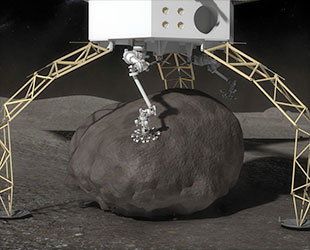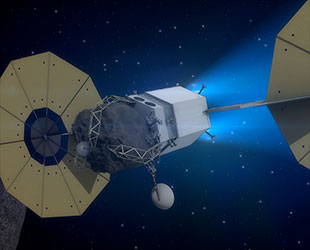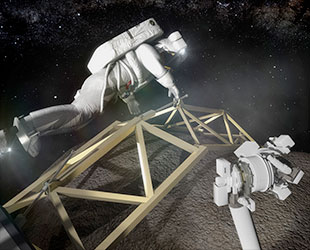March 25, 2015 — NASA will grab a boulder, rather than bag an asteroid, for its astronauts to then explore near the moon, space agency officials said on Wednesday (March 25).
The Asteroid Redirect Mission (ARM), which NASA first proposed in 2013 to test a number of capabilities needed for human expeditions into deep space, including to Mars, was at first planned to move a small asteroid into a stable orbit around the moon. A second option however, to pluck a boulder off the surface of a large asteroid won the favor of a NASA review on Tuesday for its applicability to future missions, in addition to its potential to enable science and demonstrate planetary protection techniques.
"There was a significant debate around extensibility," said Robert Lightfoot, NASA's associate administrator, in a call with reporters on Wednesday. "What's more extensible for us; systems we can use as we continue our journey after this mission."
"ARM is an important part of the overall mission of taking humans further into space," Lightfoot said.

Artist concept of NASA's Asteroid Redirect Mission spacecraft as it captures a boulder off the surface of an asteroid. (NASA) |
As now envisioned, NASA will launch the uncrewed ARM spacecraft in 2020 on a two-year journey out to a target asteroid. Once there, it will deploy robotic arms to capture a boulder up to 13 feet (4 m) in diameter from the surface.
The probe will then move into orbit around the asteroid to use its own mass and the mass of its captive rock to very minorly influence the path of the asteroid during a period that could last upwards of one year. That experience and data acquired through the demonstration could help NASA develop techniques for moving an asteroid off an Earth-impacting course, if and when that becomes necessary.
The ARM spacecraft, boulder in tow, will then place the large rock into a distant retrograde orbit around the moon by 2025. From there, a crew of two NASA astronauts will fly aboard an Orion spacecraft on a 24 to 25 day mission to rendezvous and dock with the probe and boulder, where they will both spacewalk to collect samples of the asteroid mass while testing out new spacesuits designed for use in deep space.
Overall, the $1.25 billion Asteroid Redirect Mission as now planned will span six years.

Artist concept of NASA's Asteroid Redirect Mission spacecraft as it returns a boulder using solar electric power (SEP). (NASA) |
Throughout the mission, the ARM robotic spacecraft will test capabilities needed for crewed deep space missions, including advanced solar electric propulsion (SEP), which converts sunlight to electrical power and then applies it to propelling charged atoms to move the spacecraft.
"Solar electrical power is a critical technology we want to develop on our path to Mars," Lightfoot remarked. "We are thrilled to be able to demonstrate it with this mission."
While slower than conventional chemical propulsion, SEP-powered spacecraft need less propellant and, as a result, fewer launches for human exploration missions, potentially reducing costs.
NASA does not plan to select the specific asteroid for the ARM mission until 2019, about a year before launching the craft. The agency has however, identified three candidate asteroids so far: Itokawa, the asteroid sampled by Japan's Hayabusa probe in 2005; Bennu, destination for NASA's 2016 OSIRIS-REx sampling mission; and 2008 EV5.

Artist concept of an astronaut investigating the boulder placed by the Asteroid Redirect Mission into orbit around the moon. (NASA) |
"For 2008 EV5, which we have identified as the candidate we're doing our detailed [mission] design against, [it] has not been visited by spacecraft and there are no plans [to do so] until we get there with the ARM spacecraft, if that is what we choose as the target for the mission," Lindley Johnson, NASA's Near Earth Object program executive, told reporters. "But it has been extensively observed [to determine] it is a carbonaceous Type-C asteroid, which is of particular interest to scientists because of the volatiles and elements we know to be in those types of asteroids."
"We've a very good idea of its size, shape, spin dynamics and the potential existence of the right-size boulders on its surface," Johnson said.
With the concept review completed, the ARM mission will next advance to an acquisition review this July and then enter what NASA refers to as a "Phase A" formulation.
"When you think about what we are trying to do with the Asteroid Redirect Mission, it's bringing together the best of NASA's exploration, science and technology portfolios and gives us an opportunity to demonstrate the capabilities we are going to need for human missions beyond low Earth orbit and ultimately to Mars," Lightfoot stated. "It is pretty exciting."
